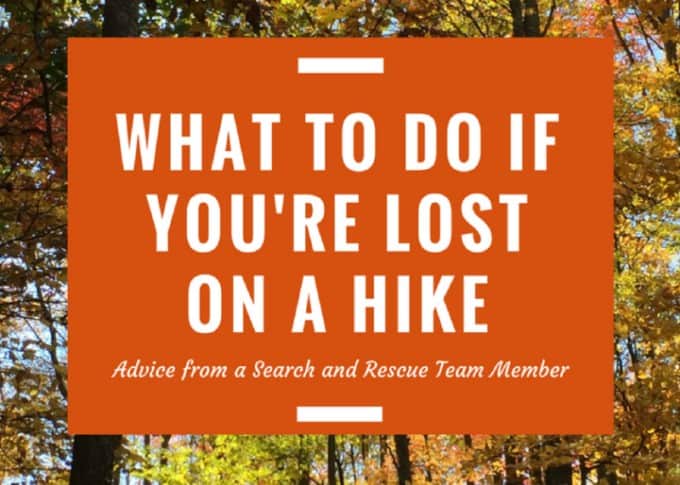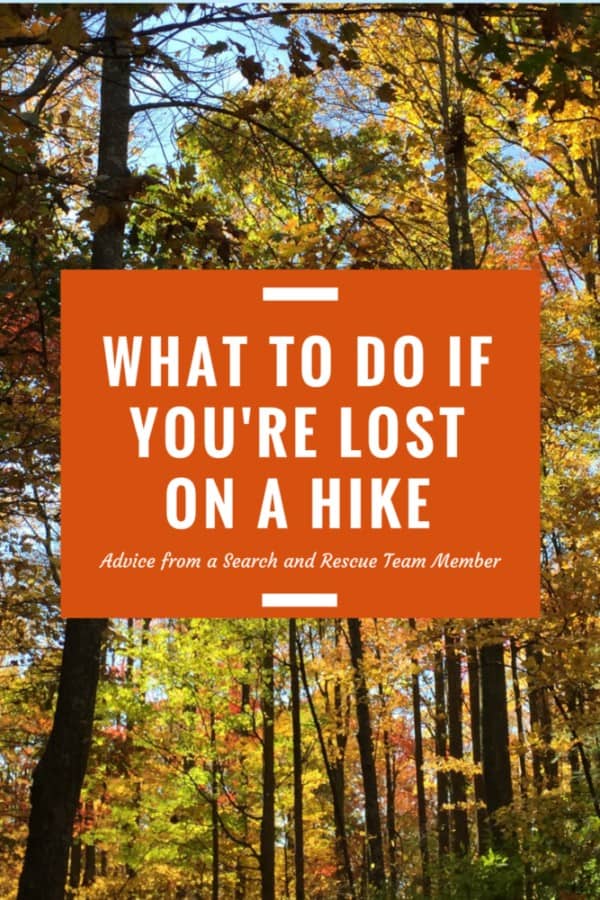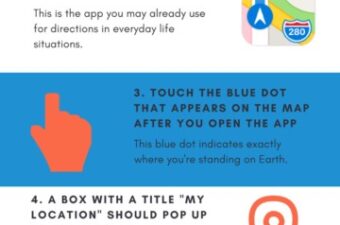- Part I: What you should always do and put in your backpacking before going on a hike
- Part II: What you should do if you’re lost on a hike (this post)
- Part III: What your kids should always have with them on a hike to stay safe
- Part IV: What steps you should take to keep your dog safe on a hike and how to treat them for common injuries/illnesses until you get them out of the woods.
In the first post of this series, you were introduced to David and his hiking companion, two young men who were lost in the woods of western North Carolina in January for 55 hours, surviving temperatures well below freezing, snow, and strong winds, all with minimal gear and clothing. Their story is a lesson in both resiliency and courage, and they undoubtedly learned volumes from their experience.
In that post, I covered the essential steps you should take before leaving for a hike and what you should always have in your backpack on a hike, no matter how long or short. Sometimes though, despite your best efforts, you find yourself lost (or injured).
So what the heck do you do if you find yourself in this situation? First, pat yourself on the back for bringing your 10 essential “systems,” because it’s going to make a world of difference in your ability to overcome this predicament! If you’re wondering what the heck I’m talking about, because the only 10 of anything you brought was M&Ms, then I implore you to read this post first.
Let’s assume you’re well prepared though. Even in the best of circumstances, a search and rescue team will typically take several hours to reach someone in need. Add hazardous temperatures and/or weather to the mix, and instantly, every second counts. For a hiker, it can literally mean the difference between life and death, depending on their choices before heading out and the steps they take once they’re in a compromising situation. I imagine the time it takes to be found or rescued must tick by excruciatingly slow, even for the most prepared hiker. It would be easy to let panic set in, thinking help was never coming.
This brings me to my first point, and it’s a big one: As soon as you realize you’re not sure where you are, STOP HIKING!
Once you stop, the next step is to think of the word “stop” as an acronym. Here’s what it stands for:

Let’s break it down:
- Stop at the first sign of feeling unsure of your whereabouts.
- Think about the last point you knew where you were for certain. Is it far back? How long ago was that point?
- Observe your surroundings and pull out your map and compass. Can you figure out a general area where you might be, based on landmarks and reading your map?
- Plan what you should do next. If you’re certain you aren’t far off course and can simply hike back to the point where you knew where you were, then do that.
Let’s say you don’t have a clue where you got off course, or you thought you knew until you started hiking back and realized you’re more mixed up than you initially believed. Once you’ve calmed yourself down and know you’re going to be okay because you’re smart enough to figure your way out of this mess, take out your phone (that should be in airplane mode or off, prior to this!) and see if you have a signal.
If you’re lucky and you can make a phone call, perfect. If you don’t have a signal but can see the trail you’re on (assuming you’re still on a trail) leading to an area of higher ground, walk there and see if you can find a spot of reception.
If you’re able to find cell reception, this is not the time to waste your battery and call your mom, your significant other, or someone else you might feel like crying to, because you need to conserve your battery! Instead, take the following steps:
1. Call 911
2. Tell them that you are lost with as many specifics as you know at this point (trail name, wilderness area, national park, etc.).
3. VERY IMPORTANT TIP: The operator you’re speaking with may not know to ask, but make a point to tell them you’d like to share your coordinates from your phone for search and rescue. This is incredibly important and will give them your exact location versus a general area from towers that are pinged from your phone when you made the call. Here’s how you do it:
- Make sure locations services is set to the “on” position. To do this go to Settings > Privacy > Location Services
- Open Apple Maps App
- Touch the blue dot on the map you see after the app opens.
- A box with a title “My Location” should pop up below the map.
- Scroll down and you’ll find latitude and longitude coordinates to share with the operator.
- Occasionally, even if you can’t make a call, you can still send a text message. If that’s the case, send a text to the person you left your itinerary with before you left, indicating you’re lost. You can also send them these coordinates by using the option, “Share My Location” after clicking on the map’s blue dot.
On an Android, take the following steps:
- Open Google Maps
- Press the blue dot and hold it until a red “pin” is dropped on the map.
- Touch the dropped pin and your lat/long coordinates will show up near the bottom of the screen (or possibly in the bar at the top of the screen).
This small step can make a search and rescue team’s job much easier to know exactly where you are (and gets you out of the woods much more quickly)!
If you don’t have an iPhone, you still have a great option to give your coordinates by downloading an app called UTM Position Mailer. It costs $1.99, but I think your life is worth that much, don’t you? This app will give you both latitude and longitude coordinates as well as something called UTM coordinates below. Give both to the operator since most SAR teams operate with UTM coordinates.
What you should NOT do on this phone call is break down and tell them how scared you are or that you’d like him/her to transcribe your final words to your loved ones. You’ve got to keep it together!
In our winter survival story of David and his friend’s ordeal, one of the things that impressed our search and rescue team the most was how calm he was on the 911 call he made, when he was nearly 48 hours into his ordeal. You can listen to the actual call on my first post of this series. I asked David how he was able to stay so calm and what was going through his head at that point. He told me this:
I’ve heard that many times, that I sounded calm and collected on the 911 phone call. That is far from the truth. I was falling apart on the inside. I was in tears. As unstable as I was, I was facing the reality of it. I knew how important it was for the 911 dispatcher to clearly make out everything I was saying, and for me to hear what he was speaking back to me.”
The importance of remaining calm in a situation like this cannot be overstated, and David’s behavior is a perfect example of how it helped him.
Once you disconnect from the call, put your phone back in airplane mode or turn it off, and stay put! Whether you were able to share your location or not, cell towers should have been “pinged” and will triangulate your location, usually providing SAR teams a fairly accurate idea of where you are located. If you move a good distance from where you are, it makes it that much harder to find you. For the record, David’s phone was not pinging the towers, for some unknown reason, and that’s what made it incredibly hard for our teams to locate them.
4. Pull out what you need to get comfortable for a while from your backpack. Continue to stay calm and know that you’re going to be okay because you’re a smart hiker who came well prepared for a situation like this.
Okay, so you may be reading this and wondering, “But what if I’m not as prepared as I should be?” While your odds of survival certainly decrease with challenging conditions, there is still plenty you can do to save yourself. Remember, David and his friend weren’t as prepared as they should have been, but they made it work because they dug deep and figured it out. Here’s what David had to say about it:
Those few days in the wilderness required my hiking companion and I to go to ends and perform necessary tasks neither of us had been predisposed to. We became experts at lighting fires, aggregated what materials we had to create a bed in a tree, built a makeshift shelter with dead tree trunks, limbs, and branches, drank water from the stream, and more. Looking back, I’m proud of the boy scout I was (and had to be) over the time lost in the woods. I hadn’t known of these survival skills I carried with me. But then again, until you are faced with an unforeseen and desperate situation, you don’t realize what you are capable of.”
David’s story is another great example of something called PMA, which stands for Positive Mental Attitude. If you don’t believe you’ll figure a way out of the mess you’re in, you probably won’t.
I asked David about this, in regards to that distinctly calm 911 call and where his head was at that point, knowing he absolutely needed to be found that day in order to survive.
Fortunately, that call was not my last phone call or my last chance of being found, but at the time I believed the chances of that being true were high. I was able to maintain a positive attitude, pull the weight, and take the lead for both of us the first 2 days. On the third day, my hiking companion had to take the lead and give direction. He had to encourage me to keep going. The freezing conditions had taken a real toll on my mental state and ability to stay optimistic.”
Not every hiker will have a friend to help carry the emotional weight, but I’m so thankful that David did and now knowing more about the kind of person he is, I believe he would have pulled it off solo. Positive Mental Attitude. It’s free and doesn’t weigh a thing, so carry an abundance of it with you each hike. It may just save your life.
Aside from all the things you carry in your pack and in your heart and head, if you are ever rescued in a situation like this, be sure to thank the people who find you. Search and rescue teams are largely volunteer organizations. It’s a service I’m honored to be a part of, and sometimes I shake my head in disbelief that I get to be a part of something so amazing.
That being said, date nights are interrupted, kid activities are sidelined, or dinners are not made when we receive calls. And there are certainly people we rescue in precarious situations and our own lives are at risk. I don’t write these things to complain, because I absolutely love what I do (and I know every person on our team would say the same thing); however, I hope it’s one more incentive to be smart in the woods and to thank the folks who find you, if you do need help. David undoubtedly understood this point as he told me:
If it happened the way it was told and explained to me, the fact we were eventually rescued Saturday after dark was miraculous. Whether we were spotted by the infrared technology found in the chopper together with the tiny flare of the lighter we were so desperate for someone to see, or by the icy white and blue snowflake blanket I was twirling around in the air as fast as the chopper blades were spinning, it was indeed the most surreal feeling of relief and gratitude I’ve felt and maybe will ever feel in my lifetime. The point I’m trying to make is that although a positive attitude had contributed somewhat to our rescue, it’s not what ultimately found and saved us. The persistence and bravery of those searching, technology, and luck found us.”
For months I wondered if this experience would scar David to the point of never returning to the woods. If he would be too fearful of the unknowns, even if he was adequately prepared. I’m happy to report that’s not the case. He told me has hiked 2-3 times in the nine months since this incident…and undoubtedly with a hell of a lot more stuff in his pack. With anything in life, what doesn’t kill us makes us stronger. David is no exception to that adage. When I asked him what he learned from the experience he told me,
The experience weighed on my body physically and temporarily, and even more so mentally. I still think about it often today, nearly 9 months after. Although my fingers were peeling, my toes pained me (from the frost bite), and I constantly was working myself up and replaying what seemed like forever in the wilderness, I showed remarkable resilience. The following Friday after being rescued on the previous Saturday, I found myself at one of my first spring semester classes. On the first day of Marketing Analysis and Decision Making, I can remember going around the room introducing ourselves to the class and sharing something interesting. When it was my turn, I introduced myself- “Hi, I’m David Crockett, I’m a double major in accounting and finance. A week ago today, I was lost in the North Carolina mountains. A day later, I was found and rescued. I was lost in freezing cold weather for over 55 hours with insufficient supplies and food.” Professor Jennifer Stuart following my introduction with “David, we are very happy and thankful to have you in class today.”
Yes, indeed, there are many who are thankful for David and his hiking companion’s safe return. Truly, one of the happiest moments of my life took place as I was standing in the frigid air of late afternoon as the sun was beginning to set, hearing over our radios that they had been spotted by one of the helicopters. It’s amazing the love and compassion you can feel for a complete stranger in situations like this. The hiking community is a group I feel pretty strongly about protecting, so do me a favor if you’re one of those people–stay prepared and be safe out there!
The rest of this series of posts pertaining to hiker safety are as follows:
- Part I: What you should always do and put in your backpacking before going on a hike
- Part II: What you should do if you’re lost on a hike (this post)
- Part III: What your kids should always have with them on a hike to stay safe
- Part IV: What steps you should take to keep your dog safe on a hike and how to treat them for common injuries/illnesses until you get them out of the woods.
If you think this information is useful, I encourage you to share this post (and the prior one) with your hiking friends via social media, email, etc.
P.S. Quality gear is a key component to keeping folks safe in the backcountry, and I never want someone’s budget to limit their preparedness. I have helped countless people outfit their packs with the gear they need at a reduced price, by curating the best deals and sales I can find in the outdoor industry and sharing them with my readers. Head over here if you’d like to see what I posted today.
[content-upgrade id=”3163″]


